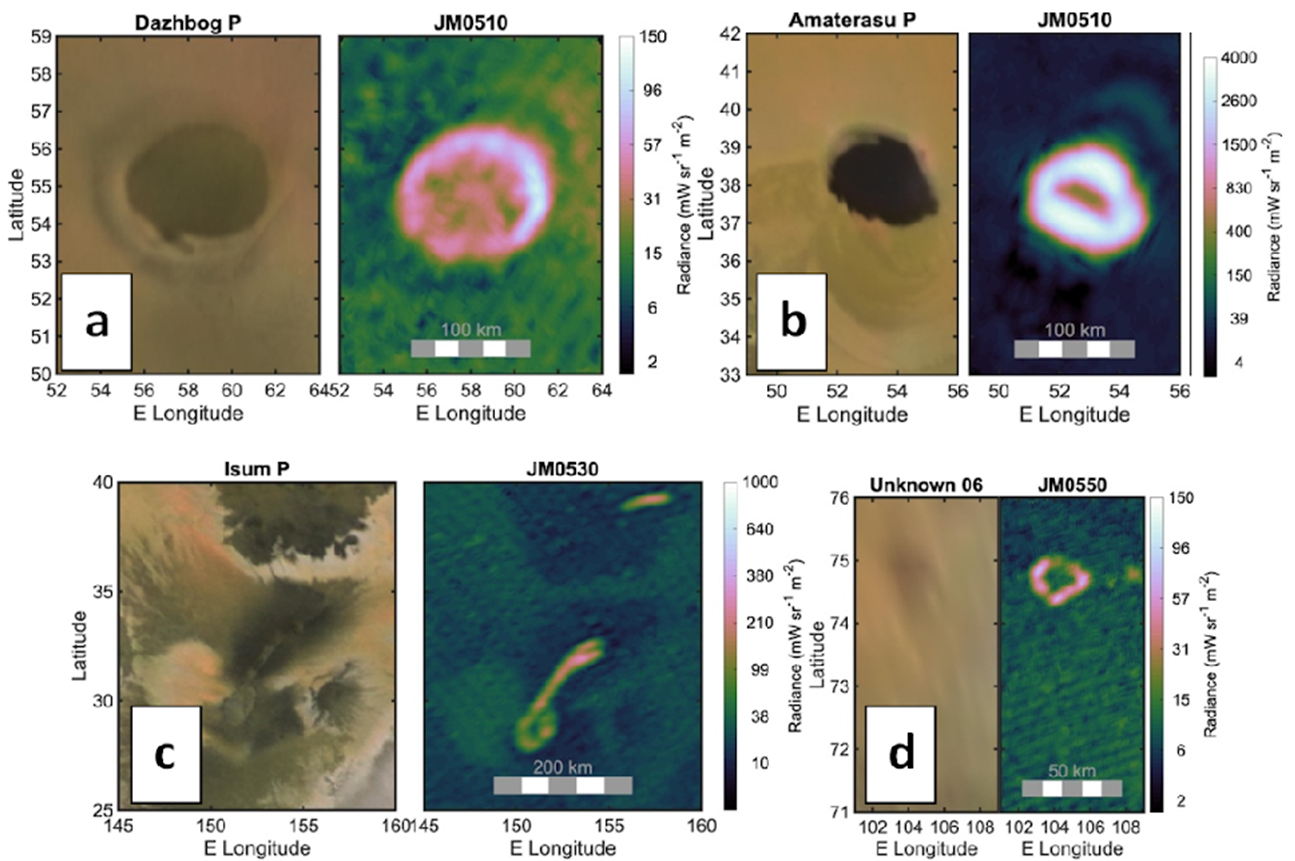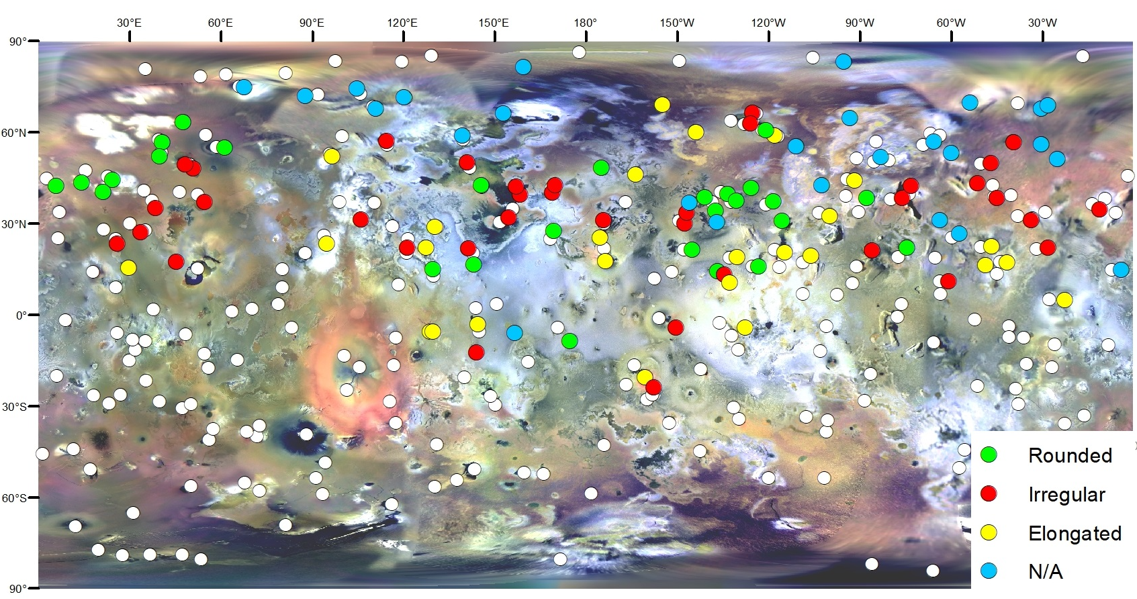Morphological characterization of Io’s paterae and their geological context.
- 1Istituto Nazionale di Astrofisica, Rome, Italy (melissa.mirino@inaf.it)
- 2Southwest Research Institute, San Antonio, Texas, USA
- 3Arizona State University, Tempe, Arizona, USA
- 4Planetary Science Institute, Tucson, Arizona, USA
- 5University of Colorado Boulder, Boulder, Colorado, USA
- 6Jet Propulsion Laboratory, Pasadena, California, USA
- 7Agenzia Spaziale Italiana, Rome, Italy
Introduction: Jupiter’s moon Io is the most volcanically active body in our Solar System [e.g., 1]. Its surface is enriched of volcanism products such as widespread lava flows and pyroclastic deposits which suggest the presence of both effusive and explosive eruptions [1]. Among the candidate volcanic explosive centers are irregular and complex craters with scalloped edges, steep walls, and flat floors called paterae [2]. By their morphology, paterae have been interpreted as candidate caldera created by the collapse of magmatic chambers [2]. This interpretation is supported by their irregular arcuate shape and their association with mountains or plateaus which suggest tectonic influences [e.g., 2]. However, the debate of their formation and their geological nature is still active and under study, since data resolution from the image mosaic obtained from past NASA Galileo and Voyager missions is not always high enough to allow a deeper morpho-geological analysis of all the paterae identified on the surface [e.g., Fig. 1d].
In recent years, remote sensing instruments onboard the NASA Juno mission [3] collected Io data at increasingly higher spatial resolution [e.g., 4]. The resolution attained in three orbits in 2023 (49, 51, 53) has allowed to observe both the morphology and the reflectance proprieties of Io’s paterae with unprecedented detail (Fig. 1). Paterae’s morphological characteristics have been observed and revealed by extracting information from a larger dataset including: (i) The Global image mosaic obtained from Galileo-Voyager [5], (ii) the Global Digital Terrain Model [6], (iii) the global USGS Io’s geological map [1], (iv) Juno/JunoCam [7], and (v) Juno/JIRAM [8]. The morphological analysis has been performed considering the planimetric view (walls and floors) and the transversal cross section. We have added the features which are often associated with paterae (such as lateral flows) and the geological units which are related with each studied patera. Then, we have used the images of paterae as observed by JunoCam to interpret the flux variability and distribution on the surface of the studied features to support geological interpretation for the paterae morphological aspect, evolution, and activity. The ESRI ArcGIS software has been used for this study. Here, we report the results of a morphological breakdown of Io’s paterae performed at different levels, by using the visible images from the global mosaic and the latest images from JunoCam, coupled with infrared data collected by JIRAM. Then, we present statistics and the global distribution of the various patera types based on the different levels of the classification framework (example in Fig.2).

Figure 1: Examples of different morphological characteristics of paterae on Io’s surface as seen from visible images (global Galileo/Vikings mosaic) and JUNO-JIRAM processed images. Example of all paterae classified as active by using JIRAM radiance data and as a- Rounded, b- Irregular, c- Elongated and d-N/A in visible images.

Figure 2: Example of a global view of Io’s surface presenting a preliminary global survey performed by using only information from the Global image mosaic. Paterae extracted from the JUNO orbits 41-49 have been classified as rounded (green dots), irregular (red dots), elongated (yellow dots), and not available (N/A) when the resolution was not enough to get the information (blue dots). White dots indicate the position of the other paterae mapped on the surface of the moon from the other orbits.
Acknowledgments: This work is supported by the Agenzia Spaziale Italiana (ASI). JIRAM is funded by the ASI–INAF Addendum n. 2016-23-H.3-2023 to grant 2016-23-H.0. Part of this work was performed at the Jet Propulsion Laboratory, California Institute of Technology, under contract with NASA.
References: [1] Williams et al., (2011), Geological Survey Scientific Investigations Map 3168, https://pubs.usgs.gov/sim/3168/. [2] Radebaugh et al., (2001), Journal of Geophysical research, https://doi.org/10.1029/2000JE001406. [3] Bolt et al., (2017), Space Science Review, https://doi.org/10.1007/s11214-017-0429-6. [4] Mura et al., (2020), Icarus, https://doi.org/10.1016/j.icarus.2019.113607. [5] Becker & Geisslet, (2005), Lunar and Planetary Institute Science Conference Abstracts 36. URL: http://www.lpi.usra.edu/meetings/lpsc2005/pdf/1862.pdf [6] Kersten et al., (2021), Planetary and Space Science, https://doi.org/10.1016/j.pss.2021.105310. [7] Orton et al., (2017), Geophysical Research Letter, https://doi.org/10.1002/2016GL072443. [8] Noschese et al., (2020), Advance in Space Research, https://doi.org/10.1016/j.asr.2019.09.052
How to cite: Mirino, M., Mura, A., Zambon, F., Tosi, F., Nodjoumi, G., Bolton, S., Ravine, M., Hansen-Koharcheck, C., Bagenal, F., Lopes, R., Sindoni, G., and Plainaki, C.: Morphological characterization of Io’s paterae and their geological context., Europlanet Science Congress 2024, Berlin, Germany, 8–13 Sep 2024, EPSC2024-547, https://doi.org/10.5194/epsc2024-547, 2024.